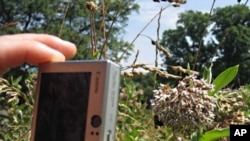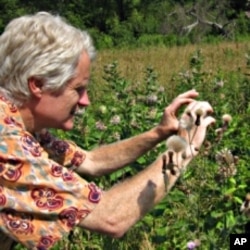Volunteers equipped with nothing more than digital cameras are taking part in an unusual bee hunt.
It's part of an environmental study that has amateur photographers documenting the impact of climate change, pollution and other factors on the interplay between plants and the creatures that pollinate them.
Freeze frame
Bees pollinate $10 billion worth of fruits, nuts and a variety of row crops each year in the United States.
Yet recent declines in the population of these essential insects threaten the lucrative agricultural industry.
Sam Droege, a researcher at the US Geological Survey's Native Bee Inventory and Monitoring Lab, is examining possible causes for the bee decline. Working with an online environmental encyclopedia called, "Discover Life," Droege has helped organize the Bee Hunt study.
Bee hunters across the United States take pictures of pollinators and the plants they pollinate, and then upload them to the "Discover Life" website. The online database keeps track of trends in pollinator populations that show the effects of climate change, pollution or invasive species.
Tracking pollinator populations
Droege's lab is filled with boxes of dead bees at various stages of identification, but the part of his job he seems to really enjoy is being outside hunting for live bees.
After a short, bumpy car ride, Droege stops at a small grassy field filled with milkweed, Canada thistle and bees. He feels there is an urgent need for a large sampling of pollinator populations across the United States.
"There's no bureau census of bees," he says. "So we are trying to create that in any way possible. There's not a lot of funding, so having citizens collect that kind of information would be advantageous."
Information on the status of pollinators helps researchers understand exactly how factors, such as disease or pollution, impact the numbers of these important insects.
Bee hunters
Amateur naturalists begin their bee hunts by noting the time of day and location they are photographing.
Once they find some bees, or other pollinating insects such as wasps, butterflies and beetles, it's time to pull out the camera and get some good close-ups. The volunteers upload the photos to the "Discover Life" website, where free online tools and experts are available to help identify the insects and the plants they're pollinating.
So far, 50 bee hunters across the U.S. have contributed to the database. Stephanie Urquhart took pictures of pollinators in the state of Oklahoma. She became interested in the study when she first heard that bees were disappearing due to an occurrence called colony collapse disorder.
"My family, my father and my grandfather, they were beekeepers. And so when I heard that news, I knew what that meant. And it really scared me." Urquhart began researching colony collapse disorder and learned that, as far back as 1996, about 40 percent of the nation's wild pollinators had disappeared. "That includes bees, bats, butterflies, moths, the whole gamut."
In addition to her desire to help scientists understand what is causing this pollinator decline, Urquhart also uses Bee Hunt as part of her home-schooling routine with her two young daughters. For all three of them, she says, this is a way to have a positive impact on the world.
"With digital photography, and the internet, now people can get directly involved with this - with climate, with wildlife issues, conservation, whatever. And really contribute something meaningful, and learn about themselves and start to understand where they live and how they can interact with their environment."
Hope for the future
Fostering that community involvement in research is exactly why University of Georgia researcher John Pickering founded "Discover Life," and created Bee Hunt. With the study gaining momentum now that it has full funding, Pickering is excited to see what the data will tell us, and how we can use it.
"I don't look at doom and destruction in our future," he says. "I really feel that if we work together, network together, collect the data that we need as a society, we can really understand and better manage this planet."
Droege says combining data from multiple Bee Hunts can create an impressive database showing the status of pollinators today. It would also provide a valuable environmental baseline for understanding changes in the years to come.
"It's the foundation for all information to come. It'll be compared to, used over and over. We know that there were these kinds of bees and these kinds of critters on flowers at this time and this place. Twenty years later, 100 years later, you can go back and look at that again and you have the original data right there. You can look at it."














